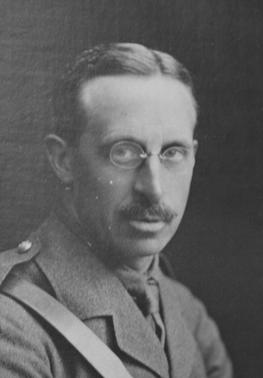
Percy Erskine Nobbs was a Canadian architect who was born in Haddington, East Lothian, and trained in the United Kingdom. Educated at the Edinburgh Collegiate School and Edinburgh University, he spent most of his career in the Montreal area. Often working in partnership with George Taylor Hyde, Nobbs designed a great many of what would become Montreal's heritage buildings and was a key Canadian proponent of the Arts and Crafts Movement in architecture. He served as the director of McGill University's School of Architecture for ten years and designed many buildings on the campus as well as McGill's Coat of Arms, which continues to be used today.
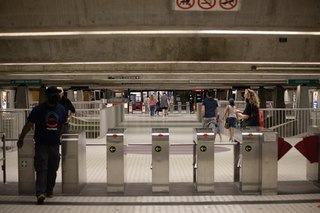
Peel station is a Montreal Metro station in the borough of Ville-Marie in Montreal, Quebec, Canada. It is operated by the Société de transport de Montréal (STM) and serves the Green Line. The station opened on October 14, 1966, as part of the original network of the Metro.

McGill station is a Montreal Metro station in the borough of Ville-Marie in the downtown core of Montreal, Quebec, Canada. It is operated by the Société de transport de Montréal (STM) and serves the Green Line. The station opened on October 14, 1966, as part of the original network of the Metro.

The Osler Library, a branch of the McGill University Library and part of ROAAr since 2016, is Canada's foremost scholarly resource for the history of medicine, and one of the most important libraries of its type in North America. It is located in the McIntyre Medical Sciences Building in Montreal.
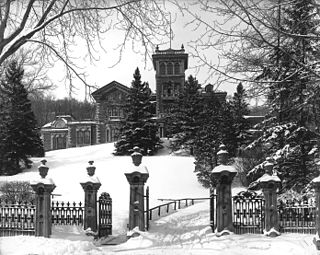
The Golden Square Mile, also known as the Square Mile, is the nostalgic name given to an urban neighbourhood developed principally between 1850 and 1930 at the foot of Mount Royal, in the west-central section of downtown Montreal in Quebec, Canada. The name 'Square Mile' has been used to refer to the area since the 1930s; prior to that, the neighbourhood was known as 'New Town' or 'Uptown'. The addition of 'Golden' was coined by Montreal journalist Charlie Lazarus, and the name has connections to contemporary real estate developments, as the historical delimitations of the Golden Square Mile overlap with Montreal's contemporary central business district.
The Presbyterian College/Le Collège Presbytérien, 3495 University Street, Montreal, Quebec, is a Theological College of the Presbyterian Church in Canada, and is affiliated with McGill University through its School of Religious Studies. The Presbyterian College's student base comes from across Canada and around the world.
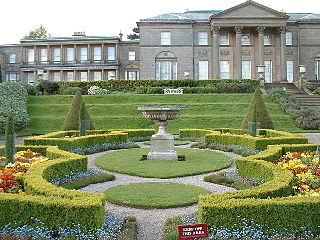
Tatton Park is a historic estate in Cheshire, England, north of the town of Knutsford. It contains a mansion, Tatton Hall; a medieval manor house, Tatton Old Hall; Tatton Park Gardens, a farm and a deer park of 2,000 acres (8.1 km2). It is a popular visitor attraction and hosts over a hundred events annually. The estate is owned by the National Trust and is managed under lease by Cheshire East Council. Since 1999, it has hosted North West England's annual Royal Horticultural Society flower show.

The Burton Barr Central Library is the central library of Phoenix, Arizona. It is the flagship location and administrative headquarters for the Phoenix Public Library. It was named in honor of Burton Barr, the Republican Majority Leader in the Arizona House of Representatives from 1966 to 1986. The library houses a collection of 1 million volumes.
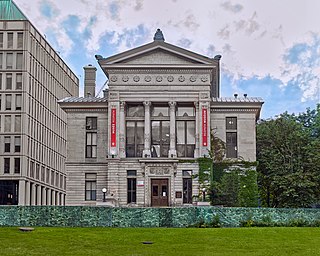
The Redpath Museum is a museum of natural history belonging to McGill University and located on the university's campus on Sherbrooke Street West in Montreal, Quebec, Canada. It was built in 1882 as a gift from the sugar baron Peter Redpath.

Burnside Hall is a McGill University building located at 805 Sherbrooke Street West, on the university's downtown campus in Montreal, Quebec. It is named after Burnside Place, the Montreal estate of James McGill, the university's founder. Built in 1970 by Marshall, Merrett, and Associates to accommodate the Faculty of Science, the thirteen-storey building is constructed in Brutalist style and stands just northeast of the Roddick Gates, in the centre of McGill's campus.

Redpath Hall is a historic building at 3461 McTavish Street in Montreal, Quebec, Canada, on the main campus of McGill University. It was originally the reading room of the Redpath Library, which opened in 1893 as McGill's first dedicated library building. During the first half of the 20th century, the library was extended several times to the south, and the expanded building became known as the Redpath Library Building. Subsequently, the adjacent McLennan Library Building was built between 1967 and 1969. Today, the Redpath-McLennan library complex houses the Humanities and Social Sciences Library, the largest branch of the McGill University Library.
The McGill University Archives (MUA) performs integrated archival and records management for McGill University. and is housed on the fourth floor of the McLennan Library Building.
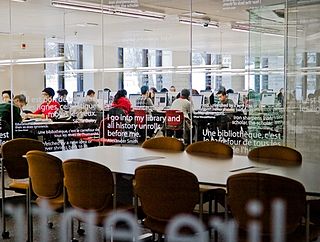
McGill University Library is the library system of McGill University in Montréal, Québec, Canada. It comprises 13 branch libraries, located on the downtown Montreal and Macdonald campuses, holding over 11.78 million items. It is the fourth-largest research intensive academic library in Canada and received an A− from The Globe and Mail's 2011 University Report, the highest grade awarded to the library of a large university.

Lady Meredith House, also known as the H. Vincent Meredith Residence, is a historic mansion located at 1110 Pine Avenue West on the corner of Peel Street, in what is today known as the Golden Square Mile of Montreal, Quebec. It was originally named Ardvarna and is now owned by McGill University. The building was designated as a National Historic Site of Canada on November 16, 1990. The house is situated at an altitude of 129 m.

The McCall MacBain Arts Building is a landmark building located at 853 Sherbrooke Street West in Montreal, Quebec, in the centre of McGill University's downtown campus. The Arts Building is the oldest existing building on campus, and it was designed in the Classical Revival style by John Ostell. Construction began in 1839, and the building's central block and east wing were completed in 1843. The west and north wings were finished in 1861 and 1925, respectively, after involving multiple architects, including Alexander Francis Dunlop and Harold Lea Fetherstonhaugh. Today, the Arts Building is made up of a central block and three distinct wings – Dawson Hall (east), Molson Hall (west) and Moyse Hall (north). The building currently houses the Department of French Language and Literature, the Department of English, and the Department of Art History and Communication Studies. It also hosts lectures for several other departments from the Faculty of Arts.

Ravenscrag is a former mansion that was built between 1860 and 1863 for Hugh Allan in the Golden Square Mile of Montreal, Quebec. It stands at 1025 Pine Avenue West at the top of McTavish Street, on the slopes of Mount Royal. Upon its completion in 1863, the mansion of 72 rooms surpassed "in size and cost any dwelling-house in Canada," exceeding Dundurn Castle, built by Sir Allan MacNab in 1835.

Rare Books and Special Collections is a part of ROAAr at the McGill University Library in Montreal (Canada), whose mandate is to
"support the teaching, learning and research needs of McGill students and faculty from all disciplines, and the wider scholarly community."

The Macdonald-Harrington Building is a building located at 815 Sherbrooke Street West, on McGill University's downtown campus in Montreal, Quebec. Designed and built in Renaissance Revival style by Sir Andrew Taylor between 1896 and 1897, Macdonald-Harrington was one of the many donations made to the university by Sir William Macdonald. Today it houses the McGill School of Architecture and the School of Urban Planning, and prior to 1987, contained the Department of Metallurgy and Mining laboratories and the Department of Chemistry.
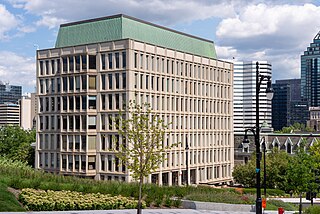
The Stephen Leacock Building, also known simply as the Leacock Building, is a building located at 855 Sherbrooke Street West, on the McGill University downtown campus in Montreal, Quebec. The building was named after Stephen Leacock, a well-known Canadian humorist and author, and Professor of Economics at McGill from 1901 to 1944. Built between 1962 and 1965 by the Montreal architectural firm Arcop, the Leacock Building's purpose was to accommodate the growing number of students at McGill, particularly in the Faculty of Arts which had outgrown its ancestral home, the Arts Building.
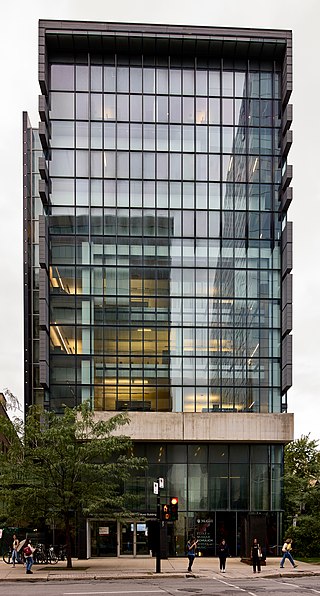
The Elizabeth Wirth Music Building is one of two buildings belonging to the Schulich School of Music at McGill University, the other being the Strathcona Music Building directly adjacent to it. The building is located at 527 Sherbrooke Street West, on the corner of Sherbrooke and Aylmer Street in Montreal, Quebec and was designed in 2005 by the Montreal-based architectural firm Saucier + Perrotte. The building officially opened in 2006, and its construction was made possible through a donation of C$20 million from McGill alumnus Seymour Schulich to the Schulich School of Music. The building was officially inaugurated as the Elizabeth Wirth Music Building on April 30, 2015, after the School received a donation of C$7.5 million from McGill alumna Elizabeth Wirth.





















